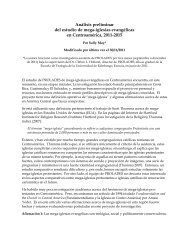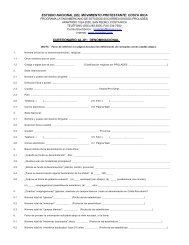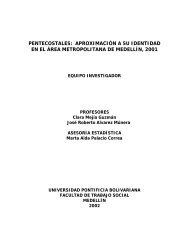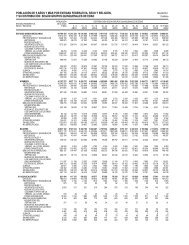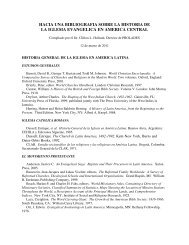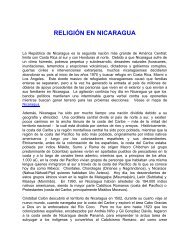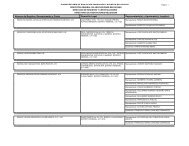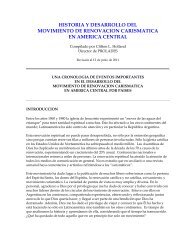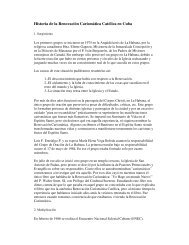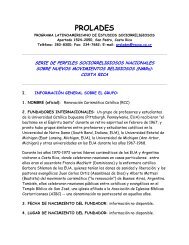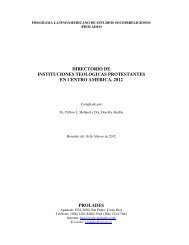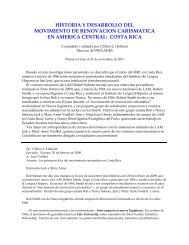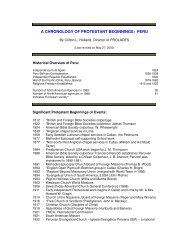THE JOHN 17:21 FELLOWSHIP (Note: this is a work ... - Prolades.com
THE JOHN 17:21 FELLOWSHIP (Note: this is a work ... - Prolades.com
THE JOHN 17:21 FELLOWSHIP (Note: this is a work ... - Prolades.com
Create successful ePaper yourself
Turn your PDF publications into a flip-book with our unique Google optimized e-Paper software.
<strong>THE</strong> <strong>JOHN</strong> <strong>17</strong>:<strong>21</strong> <strong>FELLOWSHIP</strong><br />
(<strong>Note</strong>: <strong>th<strong>is</strong></strong> <strong>is</strong> a <strong>work</strong> in progress!)<br />
By Clifton L. Holland, Director of PROLADES<br />
Draft copy on 22 September 2009 / Updated on 8 February 2011<br />
PART I<br />
It <strong>is</strong> generally agreed that one of the major ecumenical bridges worldwide between Roman<br />
Catholics and Protestants in the late 1970s and early 1980s was the John <strong>17</strong>:<strong>21</strong> Fellowship that<br />
was associated with the international min<strong>is</strong>try David du Pless<strong>is</strong>. However, until recently, little<br />
information has been available about how <strong>th<strong>is</strong></strong> organization actually came into being and how it<br />
developed. In correspondence with my friend Paul Northrup, one of the original participants in<br />
the John <strong>17</strong>:<strong>21</strong> Fellowship, a more <strong>com</strong>plete picture of <strong>th<strong>is</strong></strong> story has now emerged.<br />
The H<strong>is</strong>torical context<br />
On February 4, 1976, Guatemala City and a large part of the country (16 of 22 departments) were<br />
severely shaken by a major earthquake that reg<strong>is</strong>tered 7.5 on the Richter scale, which caused<br />
massive destruction and loss of life. According to Roger Plant (1978:5), “Of a total population of<br />
approximately 5,500,000, over 22,000 were killed, more than 77,000 injured and over 1,000,000<br />
made homeless; it was the severest natural catastrophe in Central America during the twentieth<br />
century.”<br />
The response of Protestant denominations and service agencies, both national and inter-national,<br />
to the survivors in the aftermath of <strong>th<strong>is</strong></strong> earthquake was swift and significant, both in terms of<br />
emergency ass<strong>is</strong>tance and more long-term <strong>com</strong>munity development activities. Th<strong>is</strong> produced a<br />
favorable reaction among those who received immediate as well as long-term ass<strong>is</strong>tance from<br />
evangelical organizations, with a resulting burst of growth in attendance and membership of<br />
evangelical churches.<br />
How and why the John <strong>17</strong>:<strong>21</strong> Fellowship was founded (testimony by Paul Northrup)<br />
An initial meeting took place on the first anniversary of the quake in March of 1977 at "La<br />
Posada de Don Rodrigo" in Antigua, Guatemala. David du Pless<strong>is</strong> was there as well as Bob<br />
Thomas, Ralph Wilkerson, Paul Finkenbinder, Hector Tamez, Bill Finke and myself from<br />
California, and Norman Parr<strong>is</strong>h and several members from h<strong>is</strong> church in Guatemala City who<br />
were involved in the earthquake rescue and reconstruction effort. Several others from Central<br />
and South America whose names I don't recall right now.<br />
Th<strong>is</strong> meeting was put together by Norman Parr<strong>is</strong>h, senior pastor and founder of Calvary Church<br />
in Guatemala City, and members of h<strong>is</strong> staff who had mobilized weeks before the earthquake<br />
because a woman in the church had prophesied that it was <strong>com</strong>ing.
The idea for the meeting was suggested by a Catholic priest from Bogota, Colombia, who came<br />
to Guatemala to bring aid for the earthquake victims. Th<strong>is</strong> priest was popular for h<strong>is</strong> daily radio<br />
and T.V. programs called "Minuto de Dios" broadcast carried by a national net<strong>work</strong> covering<br />
Colombia. He was also well known for an outstanding <strong>com</strong>munity he formed in a garbage dump<br />
in Bogota. I v<strong>is</strong>ited him later and was truly amazed at the transformation of both people and<br />
place.<br />
He planted the idea to <strong>com</strong>e together on the anniversary of the earthquake because Jesus prayed<br />
for spiritual unity in the Body of Chr<strong>is</strong>t, just as a natural d<strong>is</strong>aster unified Chr<strong>is</strong>tians from all<br />
nations and denominations to bring help to Guatemala. The idea resulted in a meeting bringing<br />
together people who heard about it and came because they were drawn by the Holy Spirit. David<br />
du Pless<strong>is</strong> said it was the first time in h<strong>is</strong> life that he came to a meeting without being invited.<br />
Actually there were no official invitations or special speakers or program.<br />
David began speaking to us about our personal need to forgive one another as Jesus prayed<br />
"forgive us as we forgive others." Th<strong>is</strong> became the theme for the whole week. Both Catholics and<br />
Evangelicals were there and a great spirit of prayer came over all of us as we began forgiving<br />
each other. The meeting took place on Holy Week and there was a spontaneous desire to partake<br />
of the Lord's Supper. Some of the people excused themselves because they felt they could not do<br />
<strong>th<strong>is</strong></strong> with Catholics. Later they came back asking forgiveness for not participating.<br />
John <strong>17</strong>:<strong>21</strong> was the name chosen following the meeting in Guatemala about a week later at<br />
Melodyland Chr<strong>is</strong>tian Center in Anaheim, California. Ralph Wilkerson, Bob Thomas, Paul<br />
Finkenbinder (“Hermano Pablo”), Hector Tamez, myself and others attended. Hermano Pablo<br />
made office space available in h<strong>is</strong> building in Costa Mesa, California, to coordinate meetings in<br />
the U.S., Latin America, Korea, and Singapore and beyond.<br />
Ralph Wilkerson and Bob Thomas made finances available to support Hector Tamez<br />
[coordinator] and myself [secretary] to serve full time, and Dr. David du Pless<strong>is</strong> (known as<br />
“Mr. Pentecost”) became Honorary President. Outstanding Chr<strong>is</strong>tian leaders across the U.S.<br />
got involved in the "V<strong>is</strong>ion" and it soon became a nationwide prayer net<strong>work</strong>.<br />
(E-mail correspondence from Paul Northrup to myself, dated 22 September 2009)<br />
Introduction by Clifton Holland<br />
For a long time I have been interested in d<strong>is</strong>covering more about the origin and development of<br />
the John <strong>17</strong>:<strong>21</strong> Fellowship because of its h<strong>is</strong>torical significance and due to my own limited<br />
involvement in meetings sponsored by <strong>th<strong>is</strong></strong> organization in Mexico, Costa Rica and Southern<br />
California. Some of my initial sources of information were the following:<br />
Burgess, Stanley M. and Gary B. McGee, editors. “Char<strong>is</strong>matic Movement” (pp. 130-160) in Dictionary<br />
of Pentecostal and Char<strong>is</strong>matic Movements. Grand Rapids, MI: Regency Reference Library / Zondervan<br />
Publ<strong>is</strong>hing House, 1988.
Paul Northrup, correspondence with Clifton L. Holland via e-mail in May, July and September of 2009.<br />
Research conducted by myself at the David du Pless<strong>is</strong> Collection archives at the Library of Fuller<br />
Theological Seminary in July 2009: box of information in folders about the John <strong>17</strong>:<strong>21</strong> Fellowship.<br />
Commentary by Clifton Holland<br />
I attended one of these conferences in the early 1980s (check date) and got to know many of the<br />
leaders personally, including Fr. Navarro (died in 2003), Thomas (died in 1998), du Pless<strong>is</strong> (died<br />
in 1987), Finke and Ortiz. The meetings were held at the El Altillo Monastery of the Catholic<br />
M<strong>is</strong>sionaries of the Holy Spirit in the southern part of Mexico City and at the Valle de Bravo<br />
Catholic Retreat Center in the state of Puebla.<br />
Later, I was responsible for inviting Fr. Alfonso Navarro and Robert Thomas to Costa Rica to<br />
speak at a conference for evangelical pastors in San José, sponsored by the International Institute<br />
for In-depth Evangelization (IINDEF), and held in the IINDEF building in San Franc<strong>is</strong>co de Dos<br />
Ríos (November 1981). However, there was a negative reaction against Padre Navarro because<br />
he was a Roman Catholic and the IINDEF team was criticized for sponsoring such a meeting and<br />
giving a Catholic priest such a platform to address evangelical leaders. Our team director, Rafael<br />
Baltodano, told me that I should not continue to attend UCELAM or John <strong>17</strong>:<strong>21</strong> Fellowship<br />
meetings, or any other meetings with Catholic char<strong>is</strong>matics, if I wanted to continue being on the<br />
IINDEF team. Consequently, I backed off from participating in these activities until the<br />
M<strong>is</strong>siological Institute of the Americas (IMDELA) was organized independently of IINDEF in<br />
1983 with myself as its director.<br />
In September 1985, I attended another John <strong>17</strong>:<strong>21</strong> Fellowship meeting in San Clemente, CA, at<br />
Casa Romantica Retreat Center, where about 20 Catholic and Protestant char<strong>is</strong>matics meet for a<br />
half-day retreat. Some of the participants at that meeting included Robert and Margaret Thomas,<br />
Paul and Vera Northrup, Mel and Janie Green, Warren and Margaret Campbell, Roger and Lyn<br />
Story, Robert and Sue Grant, Mercedes Duncan, Pete and Eire Carlson and Glen Anderson.<br />
Below <strong>is</strong> biographical information that I have obtained from a variety of sources about some of<br />
the major actors involved in the origin and development of <strong>th<strong>is</strong></strong> movement.<br />
BIOGRAPHICAL INFORMATION ABOUT KEY PLAYERS<br />
(1) David Johannes du Pless<strong>is</strong> (b.1905 – d.1987)<br />
The General Secretary of the Apostolic Faith M<strong>is</strong>sion (AFM) was in h<strong>is</strong> office in Johannesburg,<br />
South Africa. As it was before 7.00 am he was surpr<strong>is</strong>ed when Smith Wigglesworth burst into h<strong>is</strong><br />
office. "Come out here," he boomed. Pushing David firmly against the wall he, prophesied that a<br />
revival would <strong>com</strong>e through the old-line denominations eclipsing anything previously known<br />
throughout h<strong>is</strong>tory. Many of the leaders would change from strong opposition to accept the<br />
message and the blessing of the Pentecostal experience.
David too would have a very prominent part in <strong>th<strong>is</strong></strong> movement providing he remained humble and<br />
faithful. Smith bowed h<strong>is</strong> head, asked God to prepare David and to keep him in good health, and<br />
he left h<strong>is</strong> office.<br />
Wigglesworth was in South Africa for the annual conference of the AFM (December 1936).<br />
David was h<strong>is</strong> interpreter and Wigglesworth was staying in David's home. Ten minutes later<br />
Smith returned to David's office as though for the first time and inquired how he was. "Very<br />
puzzled," was David's reply. Smith explained he had seen a v<strong>is</strong>ion well before dawn. He had<br />
argued with the Lord about it saying, "Th<strong>is</strong> <strong>is</strong> not what my brethren expect." Smith told David<br />
that he should wait for confirmation from God and added, "It will not begin during my lifetime.<br />
When I pass away, then you can begin to think about it." Smith also told David that he would<br />
travel more than most men.<br />
Uniting the Pentecostals<br />
Three weeks after Wigglesworth's prophecy in South Africa, David du Pless<strong>is</strong> was invited to<br />
min<strong>is</strong>ter the following year (1937) at the General Council of Assemblies of God (AOG) in<br />
Memph<strong>is</strong>, Tennessee. They d<strong>is</strong>cussed the benefits of a meeting of Pentecostal leaders in 1938/9<br />
in London or some other European centre. Near the end of the conversation Donald Gee said it<br />
would be wonderful if David du Pless<strong>is</strong> could be secretary for such a meeting.<br />
A European conference was held in Stockholm in 1938 primarily to res<strong>is</strong>t any formation of an<br />
International Pentecostal Movement. It was at that conference that T. B. Barratt prophesied the<br />
<strong>com</strong>ing of World War II.<br />
The First World Pentecostal Conference<br />
Due to the war, the First World Pentecostal Conference (WPC) was not held until 1947. Th<strong>is</strong><br />
was the year that Smith Wigglesworth died. The conference was held in Zurich Switzerland and<br />
organized by the Sw<strong>is</strong>s pastor Leonard Steiner and ass<strong>is</strong>ted by David du Pless<strong>is</strong>.<br />
David du Pless<strong>is</strong> min<strong>is</strong>tered on the words of John Bapt<strong>is</strong>t, "I baptize you with water for<br />
repentance. But after me will <strong>com</strong>e one who <strong>is</strong> more powerful than I … He will baptize you with<br />
the Holy Spirit and with fire. H<strong>is</strong> winnowing fork <strong>is</strong> in h<strong>is</strong> hand, and he will clear h<strong>is</strong> threshingfloor,<br />
gathering h<strong>is</strong> wheat into the barn and burning up the chaff with unquenchable<br />
fire" (Matthew 3:11-12 NIV). God had shown David that one cannot grow wheat without chaff<br />
and that God would remove and burn it with the refining fire of the Holy Spirit.<br />
A Severe Accident<br />
One foggy night in 1948 Paul Walker, who was head of the M<strong>is</strong>sions Department of the Church<br />
of God (Cleveland, TN), was driving David back to Beckley, West Virginia. At 3.00 am they<br />
crashed into a shunting lo<strong>com</strong>otive which had stopped on a rail crossing.<br />
It was at <strong>th<strong>is</strong></strong> time that the Pentecostal Fellowship of North America was born. Their first action<br />
was to send David $400 and they also agree to send $250 a month until he recovered from the
accident. David du Pless<strong>is</strong> was now able to send h<strong>is</strong> wife Anna more than $1,000 because he<br />
wanted her to <strong>com</strong>e to America.<br />
In 1949, the family came to Beckley in time for their first Thanksgiving. David organized the<br />
1949 PWC from h<strong>is</strong> hospital bed. While he was in the hospital God told him the time of the<br />
fulfillment of Wigglesworth's prophecy had arrived. Although David was told that it would take<br />
two years to recover he attended the conference on crutches.<br />
The Church of God offered him a professorship at Lee College in Cleveland, Tennessee. Th<strong>is</strong><br />
enabled the family to obtain a residence v<strong>is</strong>a in the United States. While teaching and with help<br />
from the students, the 1952 PWC was organized in London.<br />
The Char<strong>is</strong>matic Renewal<br />
God showed David he needed to be near the centers of power of the establ<strong>is</strong>hed churches. He<br />
resigned from teaching at Lee College and moved to Stamford, Connecticut. Here David<br />
developed a friendship with Dr. John A. Mackay who was the president of Princeton Theological<br />
Seminary. At the end of the 1952 PWC, David resigned as secretary and travelled to Germany to<br />
attend the World Conference of the International M<strong>is</strong>sionary Council at the suggestion of<br />
Mackay. At the conference he talked with 110 of the <strong>21</strong>0 delegates including Dr. Willem V<strong>is</strong>ser 't<br />
Hooft, the Secretary General of the World Council of Churches (WCC). Dr. Hooft arranged for<br />
David to speak at the second assembly of the WCC in Evanston, Illino<strong>is</strong>, in 1954.<br />
David changed h<strong>is</strong> main message in two ways. First, he started to emphasize Jesus as the Baptizer<br />
in the Holy Spirit. He also started to confess h<strong>is</strong> wrong attitudes and how he overcame them. Th<strong>is</strong><br />
helped people to acknowledge their own prejudices.<br />
Pentecostal Catholics<br />
At a meeting of the WCC in St. Andrews, Scotland, David met Professor Bernard Leeming, a<br />
Catholic priest from Oxford, England, who asked for the bapt<strong>is</strong>m in the Holy Spirit. Th<strong>is</strong> was the<br />
start of David's min<strong>is</strong>try to Roman Catholics.<br />
Leeming knew Pope John personally and he arranged for David to v<strong>is</strong>it Rome. God gave David a<br />
love for Catholics. First he met Dr. Robert Murray and then Dr. Thomas Strandsky, the secretary<br />
for Promoting Chr<strong>is</strong>tian Unity. Strandsky had searched for a Pentecostal to talk to him and was<br />
told David was the only one.<br />
Strandsky's boss was Cardinal Bea who asked David, "What do the Pentecostals want to say to<br />
Rome?" David's hesitating response, "I have to say, the Pentecostals have no intention of talking<br />
to Rome." Betraying no emotion Bea asked, "What do you want to say to Rome?" David replied,<br />
"Make the Bible available to every Catholic in the world in h<strong>is</strong> own language. The Holy Spirit<br />
will make that book <strong>com</strong>e alive and that will change lives and renew the church." Bea was taken<br />
in and said, "That <strong>is</strong> what the Holy Father wants to know, write it down," he said to h<strong>is</strong> secretary.
In 1964 David was an observer at the h<strong>is</strong>toric Second Vatican Council originated by Pope John<br />
XXIII and <strong>com</strong>pleted by Paul VI. At Horgen in Switzerland in 1972, David represented the<br />
Pentecostals as co-chairman with Fr. Kilian McDonnell at the first of ten "Dialogues" between<br />
Catholics and Pentecostals, including Char<strong>is</strong>matics.<br />
According to Cecil M. Robeck, Jr., in Cooperation and the Promotion of Unity, A Pentecostal<br />
Perspective:<br />
“To date, the most significant place where broader ecumenical engagement has taken place <strong>is</strong> at<br />
the bilateral level. An international dialogue between the Catholic Church and certain Pentecostal<br />
churches and leaders has ex<strong>is</strong>ted since 1972, co-founded by David du Pless<strong>is</strong> and Fr. Kilian<br />
McDonnell, OSB. It has made some important findings during its thirty-five years of ex<strong>is</strong>tence.”<br />
Source: http://www.towards2010.org.uk/downloads/t2010paper08robeck.pdf<br />
(2) Bill Finke: an independent Pentecostal m<strong>is</strong>sionary trained at the Assemblies of God Bible<br />
College in Seattle, WA.<br />
In 1972, while living in Chilpancingo, Mexico, God also gave [Bill] the finances to purchase a<br />
new Cessna Turbo-charged six place <strong>21</strong>0 aircraft. Th<strong>is</strong> was a time when Bill taught and trained<br />
b<strong>is</strong>hops, priests, nuns and lay <strong>work</strong>ers throughout Latin and South America.<br />
Seven years later [1979], Bill and Janice moved to San Jose, California. Bill's min<strong>is</strong>try expanded<br />
into conducting leadership training conferences through out Asia, Africa, and Latin America, as<br />
well as in the United States. Bill and Janice also <strong>work</strong>ed with another couple to plant a church in<br />
Sunnyvale, California, where Bill was the senior pastor for ten years.<br />
Source: http://www.northwestu.edu/financialaid/scholarships/endowed/finke.php<br />
(3) Robert Bluford Thomas (b.1919-d.1998)<br />
Thomas was born on November 2, 1919 in Woodland, CA, and ra<strong>is</strong>ed in California. According<br />
to h<strong>is</strong> wife, Bob had a m<strong>is</strong>sionary mind since he was a young man, and he had a heart to tell<br />
others about Jesus’ saving name. After he and Margaret were married on June 25, 1939 in Santa<br />
Maria, CA, they began to prepare to go to the m<strong>is</strong>sion field. Both attended Glad Tidings Bible<br />
Institute in San Franc<strong>is</strong>co, CA, from January 1940 to December 1942. Later, they were sent by<br />
the Assemblies of God via a cargo ship to Buenos Aires, Argentina, where they served as<br />
m<strong>is</strong>sionaries from 1945 to 1950. According to Margaret, they held many evangel<strong>is</strong>tic meetings<br />
and developed a true love for the Latin American people.<br />
In 1947 the m<strong>is</strong>sionary <strong>work</strong> of the Assemblies of God was organized nationally under the name<br />
“Unión de las Asambleas de Dios en Argentina” (UADA), under the leadership of m<strong>is</strong>sionary<br />
Niels Sorensen, superintendent. In 1948, the UADA acquired legal status and formed its first<br />
board of directors, which was <strong>com</strong>posed of the following members: Erling Andersen, superintendent;<br />
Kermit Jeffrey, ass<strong>is</strong>tant superintendent; Robert Thomas, secretary; Samuel Sorensen,
vice-secretary; and Eduard Fazzini, member at large. By 1949 the UADA had 20 affiliated<br />
churches.<br />
While in Buenos Aires Bob <strong>work</strong>ed with fellow m<strong>is</strong>sionary Kermit Jeffrey (who served with h<strong>is</strong><br />
wife Erna in Argentina from 1943 to 1950) in conducting evangel<strong>is</strong>tic meetings and church<br />
services in Argentina and Uruguay, and several new churches were started that were pastored by<br />
these two m<strong>is</strong>sionaries. Kermit and Bob also began a Bible School in a local church in 1947 to<br />
train national <strong>work</strong>ers from Argentina, Uruguay and Paraguay; and they also traveled outside of<br />
Buenos Aires to <strong>work</strong>ers in other locations. Th<strong>is</strong> Bible School became the Río de la Plata Bible<br />
Institute in 1948, with Bob as its first director (1948-1950). Initially it was located in the<br />
Colegiales d<strong>is</strong>trict of Buenos Aires. Later, the Bible Institute moved to City Bell and Robert<br />
Edward Miller became its director. In 1952, Paul Sorensen became the director and Paul Brown<br />
was the ass<strong>is</strong>tant director.<br />
After returning to the USA in 1950, Bob became a min<strong>is</strong>ter in an Assemblies of God church in<br />
Fresno, CA. He and h<strong>is</strong> family began a long journey of min<strong>is</strong>try in the traditional church until he<br />
began <strong>work</strong>ing with a group of people who were new believers in Santa Clara, CA. From 1966<br />
to 1973 Bob was Associate Pastor at the Congregational Church of the Valley. He was given full<br />
freedom to preach the Word of God in all its fullness.<br />
The members of the congregation would question all kinds of life <strong>is</strong>sues. Bob was excited and<br />
challenged to pray and learn with <strong>th<strong>is</strong></strong> group and to open up to all kinds of believers from<br />
different backgrounds. Th<strong>is</strong> was when he began to question h<strong>is</strong> continued min<strong>is</strong>try in a<br />
traditional denominational-type church. Weren’t Catholic believers Chr<strong>is</strong>tian, too? Weren’t<br />
other denominations valid? Shouldn’t we partner with each other and join efforts rather than<br />
<strong>work</strong> separately? Can we all <strong>work</strong> together in our evangelizing efforts?<br />
In 1974, Bob accepted a pastorate at a church in Palo Alto, CA, which had its roots in the<br />
Assemblies of God denomination but had recently decided to be<strong>com</strong>e interdenominational. Bob<br />
had kept up h<strong>is</strong> contacts in Latin America. In 1976 the church bought property in Los Altos-<br />
Cupertino and built a beautiful sanctuary with offices and Sunday school rooms. The church,<br />
renamed Foothill Chr<strong>is</strong>tian Center, was filled with people on the first Sunday.<br />
Very soon after the 1976 Guatemala earthquake, Foothill Chr<strong>is</strong>tian Center ra<strong>is</strong>ed money to buy a<br />
new heavy-duty truck to be used in relief <strong>work</strong>. Bob and former m<strong>is</strong>sionary Paul Northrup (who<br />
served in Cuba from 1953 to 1959) drove the truck loaded with equipment and supplies to<br />
Guatemala. While they were in Guatemala City, Bob and Paul and others began an organization<br />
called the John <strong>17</strong>:<strong>21</strong> Fellowship.<br />
Through the John <strong>17</strong>:<strong>21</strong> Fellowship they began min<strong>is</strong>tering to and with believers [both Protestants<br />
and Catholics] in Mexico and Guatemala, believing that we are all one in Jesus’ name.<br />
At <strong>th<strong>is</strong></strong> time Bob met Father Alfonso Navarro [a member of the Catholic religious order “Fathers<br />
of the Holy Spirit” and a key leader in the Catholic Char<strong>is</strong>matic Renewal movement in Mexico]<br />
and began <strong>work</strong>ing closely with him and h<strong>is</strong> Catholic char<strong>is</strong>matic believers in Mexico City. Bob<br />
spent much time flying back and forth to participate in meetings that united Catholic and<br />
Protestant believers in Latin America.
During <strong>th<strong>is</strong></strong> time there was an exchange of meetings between Mexico and Foothill Chr<strong>is</strong>tian<br />
Center. Small groups were always traveling between Bob’s church in Los Altos and Padre<br />
Navarro’s par<strong>is</strong>h in Mexico City. There was a spiritual revival in these churches, both among<br />
Catholics and Evangelicals who pra<strong>is</strong>ed God together. A young people’s group began at the<br />
Foothill Chr<strong>is</strong>tian Center that grew and united both Catholic and Protestant youth.<br />
After Bob and Margaret began their “official” retirement in 1985, they moved from San Jose,<br />
California, to Prescott, Arizona. However, Bob kept up h<strong>is</strong> love of <strong>com</strong>municating with h<strong>is</strong> Latin<br />
American friends in Argentina and Mexico. During 1987, he and Margaret returned to min<strong>is</strong>ter<br />
in the Buenos Aires church that he formerly pastored in the 1940s and renewed many friendships.<br />
Bob passed into the Lord’s presence on September 28, 1998 in Chandler, Arizona. He was<br />
survived by h<strong>is</strong> wife Margaret and h<strong>is</strong> three daughters -- Deborah (Debbie) Raber, Brenda<br />
Griffith and Elizabeth (Anne) Theodos<strong>is</strong> -- who together have six children and three grandchildren.<br />
Margaret currently lives in a retirement home in Chandler, Arizona, and <strong>is</strong> still active in<br />
the Lord’s <strong>work</strong>.<br />
Source: Document written by Margaret Thomas and her daughter Debbie Thomas Raber, with<br />
editorial ass<strong>is</strong>tance from Clifton L. Holland.<br />
Date e-mail document received: May 11, 2009 (rev<strong>is</strong>ed on May 16, 2009).<br />
<strong>Note</strong>: New information for <strong>th<strong>is</strong></strong> biographical sketch was obtained by Holland from a variety of<br />
sources, including Lu<strong>is</strong>a Jeter Walker’s book, Siembra y Cosecha, Volume 2: Reseña h<strong>is</strong>tórica<br />
de las Asambleas de Dios en Argentina, Bolivia, Chile, Paraguay, Perú and Uruguay. Deerfield,<br />
Florida: Editorial Vida, 1992.<br />
(4) Hector Tamez (coordinator for Latin America)
(5) Paul Northrup (b.1930 – d.2011)<br />
In 1953, Paul and Vera Northrup planted a church in Sancti Spiritus, Cuba, which became the<br />
first church of the Buenas Nuevas (Good News) Church Association. God graciously blessed <strong>th<strong>is</strong></strong><br />
apostolic min<strong>is</strong>try and today, in spite of a repressive <strong>com</strong>mun<strong>is</strong>t regime, the association has<br />
grown to include 43 organized churches and more than 300 house churches.<br />
In 1959, Paul and Vega left Cuba after the Revolution to serve the Lord in Mexico, California<br />
and many other locations under the sponsorship of Gospel Relief M<strong>is</strong>sions (GRM), which was<br />
founded in 1959 by Paul's beloved Aunt Elizabeth Thompson in Fresno, CA to support Paul,<br />
Vera (married in 1953) in their m<strong>is</strong>sionary endeavors. Since then, the GRM has <strong>work</strong>ed<br />
effectively to implement training, ass<strong>is</strong>tance and relief programs in Latin America.<br />
Source: http://www.gospelrelief.org/index.html<br />
Paul and Vera Northrup’s son John wrote the following tribute in February 2011 after Paul went<br />
to be the Lord.<br />
Paul was a treasured dad, grandpa and mentor. Just as he was a treasure to so many who knew<br />
him. Paul served as an elder at M<strong>is</strong>sion Hills Community Church in Rancho Santa Margarita, CA,<br />
for nearly 30 years. He led outreaches across Latin America. He counseled and d<strong>is</strong>cipled<br />
generations of believers world-wide to be unwavering in their devotion to following Chr<strong>is</strong>t and<br />
relentless in pursuing unity in the Body. Paul was a gentle, fearless witness. He was a v<strong>is</strong>ionary,<br />
pioneer m<strong>is</strong>sionary.<br />
•1930 Born<br />
•1935 to 1942 Lived in Hawaii<br />
•1945 to 1948 Lived in Venezuela (h<strong>is</strong> parents served with New Tribes M<strong>is</strong>sion)<br />
•1949 to 1951 Attended Bible College (SCC Costa Mesa, CA)<br />
•1951 to 1959 M<strong>is</strong>sionary in Sancti Spiritus, Cuba<br />
•1953 Married Vera Seals in Fullerton, CA<br />
•1959 Gospel Relief M<strong>is</strong>sions founded in Fresno, CA<br />
•1961 to 1978 ABC Bible Training Center Puebla, Mexico<br />
•1954 to 1961 5 children--Ruth, Connie, Celeste, John & Randy<br />
•1978 to 2011 Served with the John <strong>17</strong>:<strong>21</strong> Fellowship for unity in the Body of Chr<strong>is</strong>t<br />
•1979 to 1981 "Jesus 80" Anaheim Stadium<br />
•1979 to 2011 M<strong>is</strong>sions Elder, M<strong>is</strong>sion Hills Community Church<br />
•1979 to 2011 Lived in Tustin & San Clemente, CA<br />
Source: http://1000memories.<strong>com</strong>/paul-northrup/biography
Pastor returns to see Cuban Evangelical church thriving<br />
By John Rice, The Associated Press - Posted 11/23/2003 12:27 PM<br />
CAMP CANAAN, Cuba — Paul Northrup ra<strong>is</strong>ed h<strong>is</strong> hands and shouted "Alelujah!" A<br />
congregation of more than 1,000 Cubans echoed back.<br />
Pastor Paul<br />
Northrup<br />
celebrates at the<br />
Cuban m<strong>is</strong>sionary<br />
church he founded<br />
50 years ago.<br />
By Jose Goitia, AP<br />
The small church that Northrup planted in central Cuba 50 years ago has grown and thrived since<br />
he left in 1959, be<strong>com</strong>ing a small part of a broad movement that Cuban evangelicals have built<br />
across their social<strong>is</strong>t nation.<br />
"They told us when we left, the <strong>work</strong> would fail," Northrup said. "There were seven churches<br />
then. Now there are 53."<br />
Northrup, now 71, and h<strong>is</strong> family came down from southern California to join with Cuban church<br />
members for a 50th anniversary celebration <strong>th<strong>is</strong></strong> month at a borrowed Method<strong>is</strong>t center called<br />
Camp Canaan, some <strong>17</strong>0 miles east of Havana.<br />
For hour upon hour, they sang, clapped, prayed and preached in a big brick church whose wideopen<br />
sides let breezes cut the tropical heat.<br />
"It makes me happy. It's kind of like our kids and grandkids," Northrup said.<br />
Northrup came to Cuba with h<strong>is</strong> wife, Vera, in 1953 as an independent [Pentecostal] preacher,<br />
carrying only "our clothes and an accordion." In Sancti Spiritus, he found a radio station that sold<br />
him time for $6 a minute and he began to preach.<br />
Soon he managed to establ<strong>is</strong>h a small church called Buenas Nuevas — "Good News."<br />
A milkman who regularly passed by grew curious and decided to enter one day. "I didn't know<br />
that by entering, my life was going to change," said El<strong>is</strong>eo Leon, who <strong>is</strong> now president of Buenas<br />
Nuevas.<br />
As Northrup built the church, Fidel Castro was building a revolution against the dictatorship of<br />
Fulgencio Bat<strong>is</strong>ta.
Northrup recalled seeing rebels that Bat<strong>is</strong>ta's men hanged from streetlights. Another day, "Bat<strong>is</strong>ta<br />
sent h<strong>is</strong> planes in at night. One had a searchlight and the other planes would strafe where they<br />
thought the rebels were."<br />
"Not that it would have done any good against a .50-caliber (gun), but we took all the mattresses<br />
we had, piled them on a bed" and hid underneath, he said.<br />
After toppling Bat<strong>is</strong>ta, Castro's revolution veered toward social<strong>is</strong>m. Relations with the United<br />
States soured and the atmosphere grew un<strong>com</strong>fortable for many Americans.<br />
Northrup said he left because h<strong>is</strong> presence could make some think of Buenas Nuevas as a U.S.<br />
church: "We felt we'd hurt them more by staying." He later went on to establ<strong>is</strong>h Gospel Relief<br />
M<strong>is</strong>sions in M<strong>is</strong>sion Viejo, Calif.<br />
Hundreds of other pastors, both foreign and Cuban, also left the country.<br />
For the next 25 years, all religions struggled under an explicitly athe<strong>is</strong>t government that<br />
d<strong>is</strong>couraged all sorts of religious faith. Believers were barred from important jobs and were<br />
viewed with hostility by officials who oversaw just about all aspects of life.<br />
"They were trying to make ends meet. There were some places they lost membership," said<br />
Marcos Antonio Ramos, a Miami-based Bapt<strong>is</strong>t preacher and h<strong>is</strong>torian of Cuban Protestant<strong>is</strong>m.<br />
But the wall was starting to crack by 1984, when Castro attended a Protestant service with Jesse<br />
Jackson. The collapse of the Soviet Bloc later led the government to abandon official athe<strong>is</strong>m and<br />
to openly, if warily, accept religious faith.<br />
The arrival of Pope John Paul II in Cuba in 1997 drew attention to the <strong>is</strong>land's Catholics, but<br />
many analysts estimate that attendance at Protestant churches has long exceeded that at Catholic<br />
services.<br />
The 1990s brought what Northrup called "a great awakening."<br />
Ramos estimated that weekly Protestant church attendance has roughly tripled since 1989 to<br />
300,000 people, with an additional 100,000 Jehovah's Witnesses, though he said the Protestant<br />
growth appears to have stalled in the last few years. He estimated Catholic attendance at about<br />
150,000.<br />
Northrup's dec<strong>is</strong>ion to reg<strong>is</strong>ter h<strong>is</strong> new church with the government in 1954 turned out to be<br />
fortunate: After the revolution, no new churches were recognized and unofficial churches, often<br />
operating out of houses, ran the r<strong>is</strong>k of being shut down.<br />
It's still hard to get perm<strong>is</strong>sion to build new churches and Buenas Nuevas has about 200 homebased<br />
worship centers. They are among thousands of such home churches that Assemblies of<br />
God, Presbyterians, Method<strong>is</strong>ts and other Protestants have sown across Cuba.
Among them are a few churches served by Carlos Rumbaut, of Ciego de Avila. He said he was a<br />
priest in the African-based Palo Mayumbe spiritual<strong>is</strong>t religion before following h<strong>is</strong> father to<br />
Chr<strong>is</strong>tianity.<br />
"I felt something strange" one day and went out walking aimlessly, he said. When he wandered<br />
across a church, Rumbaut said, he went in and found h<strong>is</strong> father there, praying for him.<br />
For Northrup, perhaps the best thing about the 50th anniversary ceremony was realizing he was<br />
not really needed for the church to develop.<br />
"The <strong>work</strong> for a m<strong>is</strong>sionary," Northrup said, "<strong>is</strong> to plant a seed, get it growing and then move on."<br />
SOURCE: http://www.usatoday.<strong>com</strong>/news/nation/2003-11-23-pastor-cuba_x.htm<br />
(6) Friar Alfonso Navarro Castellanos (b.1935-d.2003)<br />
Renovación Cr<strong>is</strong>tiana Católica en el Espíritu Santo,<br />
Arquidióces<strong>is</strong> Primada de México<br />
En México se inicia en 1970 con la autorización del Sr. Cardinal Miguel Darío Miranda en un<br />
grupo de 30 personas en el secretariado de la Pastoral Social con asesoramiento de Mons. Carlos<br />
Talavera, actual ob<strong>is</strong>po de Coatzacoalcos, Veracruz. El Papel del Padre Alfonso Navarro<br />
Castellanos y los Padres del Espíritu Santo en el Desarrollo de la Renovación Car<strong>is</strong>mática de<br />
México y otros países.<br />
El S<strong>is</strong>tema Integral para la Nueva Evangelización (SINE), fundado en México por el Padre<br />
Alfonso Navarro Castellanos, intenta llevar al cumplimiento las expresiones del Santo Padre<br />
procurando que los planes diocesanos de M<strong>is</strong>ión y Pastoral se realicen a través de las<br />
<strong>com</strong>unidades parroquiales, y el párroco <strong>com</strong>o cabeza.<br />
* * * * *<br />
The “Centro de Renovación del Altillo” (Monasterio de San José del Altillo) in southern Mexico<br />
City, led by Friar Alfonso Navarro Castellanos (b.1935-d.2003) of the Mexican Catholic<br />
religious order Congregation of M<strong>is</strong>sionaries of the Holy Spirit (Congregación de M<strong>is</strong>ioneros del<br />
Espíritu Santo), became the major center of the Catholic Char<strong>is</strong>matic Renewal movement in<br />
Mexico.<br />
Navarro was born in Guadalajara, Mexico in October of 1935. He joined the M<strong>is</strong>sionaries of the<br />
Holy Spirit and was ordained to the priesthood in 1962. He earned a doctorate in philosophy from<br />
the University of Fribourg in Switzerland and an advanced degree in theology in Rome. As a<br />
young priest, he was present during the opening of the Second Vatican Council.<br />
Following h<strong>is</strong> time in Europe, he taught philosophy and theology at various seminaries in Mexico<br />
and Peru. Beginning in 1971, he was assigned the post of Secretary of the General Com-
m<strong>is</strong>sion for Pastoral Work for h<strong>is</strong> order. He also began h<strong>is</strong> role as leader of the CCR in<br />
Mexico during that year.<br />
Constantly studious of the documents of Vatican II, post-conciliar documents, and books on<br />
m<strong>is</strong>siology -- especially topics on evangelization and cateches<strong>is</strong> -- he started a center for<br />
evangelization and cateches<strong>is</strong> in the Archdiocese of Mexico City in the mid-1970s.<br />
Th<strong>is</strong> center evolved into a m<strong>is</strong>sionary and pastoral process for a par<strong>is</strong>h in northern Mexico in<br />
1979 and a pilot "par<strong>is</strong>h" in the Archdiocese of Mexico City in 1980. The pilot "par<strong>is</strong>h," a new<br />
territory for a par<strong>is</strong>h, officially became Par<strong>is</strong>h of the Resurrection in 1984. Soon <strong>th<strong>is</strong></strong> process<br />
spread to other par<strong>is</strong>hes in Mexico City, Mexico and then throughout Latin America. Since 1985,<br />
it has been implemented in several H<strong>is</strong>panic par<strong>is</strong>hes in the USA -- initially Texas and California.<br />
In 1989, the first all Engl<strong>is</strong>h-speaking par<strong>is</strong>h began implementing the process in Quincy, Illino<strong>is</strong>,<br />
under the leadership of Rev. John Beveridge. The process has begun implementation in<br />
Nebraska, New Jersey, Florida, Oregon, West Virginia, Pennsylvania, New York, Washington,<br />
Ontario, and other places in the USA and Canada.<br />
D<strong>is</strong>tinctive of <strong>th<strong>is</strong></strong> process are its evangelization retreats, which <strong>is</strong> a renewal of the Initiation<br />
Sacraments and a deeper renewal of one's relationship to God, its small Chr<strong>is</strong>tian <strong>com</strong>munity<br />
follow-up, involvement with neighborhood min<strong>is</strong>tries, outreach to those in need, m<strong>is</strong>sionary<br />
outreach to all in the par<strong>is</strong>h territory, and social transformation. Navarro had a keen sense of<br />
looking at all min<strong>is</strong>tries and social action through the lens of evangelization.<br />
Th<strong>is</strong> process has been presented to CELAM and has the support of many b<strong>is</strong>hops throughout<br />
Latin America. Several b<strong>is</strong>hops and priests in <strong>th<strong>is</strong></strong> country have been very supportive of <strong>th<strong>is</strong></strong><br />
process as well.<br />
Since the 1980s, Navarro has conducted seminars on <strong>th<strong>is</strong></strong> m<strong>is</strong>sionary and pastoral process, called<br />
SINE (Systematic Integral New Evangelization) for many par<strong>is</strong>hes and dioceses in the USA,<br />
Latin America and Europe. It has had a tremendous impact upon many lives, many families, and<br />
many par<strong>is</strong>hes -- helping all to realize that evangelization <strong>is</strong> the essential m<strong>is</strong>sion of the Church<br />
and of their everyday lives.<br />
The Rev. Alfonso Navarro Castellanos, MSpSC, was pioneer in Catholic Evangelization. He died<br />
of a heart attack at age 67 on Monday evening, June 2, 2003. H<strong>is</strong> funeral was at Holy Spirit<br />
Par<strong>is</strong>h in Mexico City on Wednesday, June 4, 2003, where he was a pastor.<br />
Sources: http://sinecentral.org/principal.html - http://sinecentral.org/palfonso_1.html<br />
(7) Juan Carlos Ortiz (b.1935)<br />
Over thirty years ago, Billy Graham invited a number of key min<strong>is</strong>ters from around the world to<br />
an evangel<strong>is</strong>m conference in Germany. It was during that conference that Dr. Robert H. Schuller<br />
first heard a speaker that he would never forget -- Dr. Juan Carlos Ortiz of Buenos Aires,<br />
Argentina (born in 1935).
Juan Carlos began h<strong>is</strong> career as pastor and evangel<strong>is</strong>t at the surpr<strong>is</strong>ing age of sixteen in<br />
Argentina. H<strong>is</strong> dynamic and vibrant messages were so effective that a seminary granted him a<br />
special exemption and accepted <strong>th<strong>is</strong></strong> underage student with God’s fingerprint on h<strong>is</strong> life into their<br />
school. In 1956 Ortiz was ordained in the Chr<strong>is</strong>tian Assemblies of God in Argentina. By age<br />
twenty-three, Juan Carlos was preaching the gospel of Jesus Chr<strong>is</strong>t at crusades throughout<br />
Argentina.<br />
At age twenty-six, Juan Carlos married Martha Palau (evangel<strong>is</strong>t Lu<strong>is</strong><br />
Palau’s s<strong>is</strong>ter) in 1961 and later became the senior pastor of one of the<br />
largest evangelical churches in Buenos Aires, Central Assembly of God,<br />
from 1966-1978. He was one of the leaders of the Argentine Char<strong>is</strong>matic<br />
Renewal movement between 1968 and 1978.<br />
He was also a contributor at the International Congress on World<br />
Evangelization held in Lausanne, Switzerland, in 1974 along with such<br />
prominent Evangelical leaders as Billy Graham, Samuel Escobar,<br />
Franc<strong>is</strong> Schaeffer, Malcolm Muggeridge, John Stott and Ralph Winter.<br />
Since then, Juan Carlos’ min<strong>is</strong>try has expanded greatly as he min<strong>is</strong>tered at conventions, religious<br />
congresses, universities, seminaries, and churches across five continents. He has taught in a Bible<br />
College -- Instituto Biblico de la Plata -- in Argentina, and at present <strong>is</strong> a professor at the Fuqua<br />
School of Communications, which operates on the campus of the Crystal Cathedral, in Garden<br />
Grove, California. He <strong>is</strong> also Pastor of the H<strong>is</strong>panic Min<strong>is</strong>try at the Crystal Cathedral.<br />
For five years, Dr. Ortiz produced the telev<strong>is</strong>ion series, "La Hora de Poder," which was aired in a<br />
dozen Latin American countries. He has also produced two radio series, one in Argentina ("La<br />
Hora de la Fe") and one in Southern California ("Una Cita con Juan Carlos Ortiz").<br />
Some of h<strong>is</strong> books including D<strong>is</strong>cipleship, Call To D<strong>is</strong>cipleship, Th<strong>is</strong> Gospel Will Be Preached,<br />
The Cry Of The Human Heart, Living With Jesus Today and God Is Closer Than You Think have<br />
been translated into other languages establ<strong>is</strong>hing him as a world- renown author.<br />
In 1990, sixteen years after they first met, Dr. Schuller asked Juan Carlos to pastor Crystal<br />
Cathedral’s newly forming H<strong>is</strong>panic Min<strong>is</strong>try, which started with twelve people and quickly grew<br />
to five hundred, then to over 2,000 people. At the height of <strong>th<strong>is</strong></strong> church growth, Juan Carlos was<br />
diagnosed with less than a twenty percent chance of survival due to a malignant form of cancer<br />
that was spreading rapidly. After leaving h<strong>is</strong> position (after 2003) at the Crystal Cathedral due to<br />
h<strong>is</strong> illness, Juan Carlos experienced a healing miracle. He has recently returned to the min<strong>is</strong>try as<br />
the Crystal Cathedral’s interim Senior Pastor and as a speaking pastor for “America’s Telev<strong>is</strong>ion<br />
Church,” the Hour of Power.<br />
In November 2008, the Executive Team of Crystal Cathedral Min<strong>is</strong>tries received and accepted<br />
the resignation of Rev. Robert Anthony Schuller as Senior Pastor of the congregation. When the<br />
Senior Pastor position became vacant, Crystal Cathedral Min<strong>is</strong>tries asked Dr. Juan Carlos Ortiz to<br />
serve as Interim Senior Pastor. Juan Carlos <strong>is</strong> an internationally known evangel<strong>is</strong>t and founder of<br />
the Crystal Cathedral H<strong>is</strong>panic Min<strong>is</strong>try. As we begin our search for a Senior Pastor, Dr. Juan
Carlos Ortiz and the California Class<strong>is</strong> of the Reformed Church in America will continue to<br />
provide leadership and ass<strong>is</strong>tance for the pastoral staff and congregation.<br />
Located in Garden Grove, California, the Crystal Cathedral <strong>is</strong> the home base for the international<br />
Crystal Cathedral Min<strong>is</strong>tries, including a congregation of over 10,000 members and the<br />
internationally telev<strong>is</strong>ed "Hour of Power."<br />
Adapted from:<br />
http://www.crystalcathedral.org/hour_of_power/pastors/index_lc.php?contentid=3641<br />
http://www.crystalcathedral.org/events_news/media/press_releases/press_112908b.php<br />
http://crosslifebooks.<strong>com</strong>/authors_author.php?authorid=91<br />
By Mike Reynolds: I thought you might like some background information on the man who <strong>is</strong> at<br />
least temporarily replacing Robert A Schuller as the Interim Pastor of the Crystal Catheral. I<br />
personally don’t believe he will be<strong>com</strong>e the Senior Pastor as Schuller will be looking for a<br />
“name” pastor that matches h<strong>is</strong> theology. As to just what that <strong>is</strong> I will deal with that tomorrow<br />
afternoon.<br />
Ortiz was for many years the pastor of a large Pentecostal congregation in Buenos Aires,<br />
Argentina. He became internationally known through the 1974 Congress on World Evangel<strong>is</strong>m in<br />
Lausanne, and the publication of h<strong>is</strong> first book, “D<strong>is</strong>ciple” in 1975.<br />
Ortiz believed that the Church must reform its structures and rebuild into flexible “new<br />
wineskin,” in order to do the job of forming a united world <strong>com</strong>munity of believers. Here <strong>is</strong> a<br />
quote from h<strong>is</strong> book.<br />
“God <strong>is</strong> going to have a new <strong>com</strong>munity. Things are starting to happen in the Church. The world<br />
generally doesn’t know it yet, but it’s <strong>com</strong>ing. We are going to be like a city on a mountain, an<br />
example of a <strong>com</strong>munity that loves one another… once it starts with the pastors, it will spread<br />
quickly to the other parts of the Body of Chr<strong>is</strong>t in our cities. When Jesus looks at your city, he<br />
sees h<strong>is</strong> shepherds and sheep as all one unity. If we are in Jesus, we will see the same thing. Not<br />
all of us have the “right” doctrine, but that doesn’t seem to stop Jesus from loving us anyway.<br />
Neither should it stop Jesus’ servants.” (Pp 55, 59, “D<strong>is</strong>ciple”)<br />
Source: http://obadiah13<strong>17</strong>.wordpress.<strong>com</strong>/2008/12/18/juan-carlos-ortiz-replaces-robert-aschuller-as-interim-pastor-of-crystal-cathedral-by-tricia-tillin/<br />
ADDITIONAL HISTORICAL INFORMATION:<br />
Charles Simpson, “Covenant, The Cornerstone of Community,” in New Wine Magazine, Vol. 13,<br />
No. 9, September1981: http://www.csmpubl<strong>is</strong>hing.org/pdf/newwine/09-1981.pdf<br />
“I am privileged to be a member of a Chr<strong>is</strong>tian organization called John <strong>17</strong>:<strong>21</strong>, which <strong>is</strong> led by<br />
David Du Pless<strong>is</strong> and Ron Haus and <strong>is</strong> dedicated to the pursuit of unity among Chr<strong>is</strong>tians.”
* * * * *<br />
(8) Ron Haus, Pastor of the Church on the Hill, in Vallejo, California, and chairman of the<br />
conference, informed all present of the purpose of the gathering--"reconciliation." He then<br />
introduced David du Pless<strong>is</strong>, who shared the testimony of h<strong>is</strong> many years in Pentecost and spoke<br />
on the need for unity and forgiveness. – also, Des Evans, a Ft. Worth pastor was on the John<br />
<strong>17</strong>:<strong>21</strong> planning <strong>com</strong>mittee…<br />
One of the John <strong>17</strong>:<strong>21</strong> conferences was held in Dallas, TX, from February 7-9, 1980, called<br />
Char<strong>is</strong>matic Leadership Convocation, with about 400 participants. The features speakers<br />
included David du Pless<strong>is</strong>, Ralph Martin (a leader in the Catholic Char<strong>is</strong>matic Renewal), Juan<br />
Carlos Ortiz, John Johnson (a black char<strong>is</strong>matic leader), Larry Chr<strong>is</strong>tianson (a Lutheran<br />
pastor) and Bob Mumford.<br />
Don Basham, “A Time to be Reconciled,” in New Wine Magazine, Vol. 12, No. 5, May 1980:<br />
http://www.csmpubl<strong>is</strong>hing.org/pdf/newwine/05-1980.pdf<br />
See: “Final Report” in Pneuma, Volume 12, Number 1, 1990, pp. 97-115(19).<br />
See: "An Exerc<strong>is</strong>e on the Frontiers of Ecumen<strong>is</strong>m": Almost Thirty Years of Roman Catholic-<br />
Pentecostal Dialogue” by Kärkkäinen, Veli-Matti in Exchange, Volume 29, Number 1, 2000, pp.<br />
156-<strong>17</strong>1(16).
PART II<br />
<strong>Note</strong>s on my research at the David duPless<strong>is</strong> Collection archives at the David Allan Hubbard<br />
Library at Fuller Theological Seminary on 23 July 2009: Mrs. Nancy Gower, Associate<br />
Archiv<strong>is</strong>t. Review of documents.<br />
1. August 1, 1977 report:<br />
Board of Directors formed in the USA<br />
Ron Haus, President<br />
Bob Bush, VP<br />
Paul Northrup, Secretary<br />
Bob Thomas, Treasurer<br />
Hector Tamez, Coordinator<br />
Elmer Bueno, Latin American Ambassador<br />
Ralph Wilkerson, Ambassador-at-large<br />
Coordinators named for Latin America: Hector Tamez with the ass<strong>is</strong>tance of Elmer<br />
Bueno, Bill Finke and Roger Leyton.<br />
Meeting for Central American leaders scheduled for August 22-24, 1977, in San José,<br />
Costa Rica.<br />
Minutes taken by Paul Northrup, Secretary<br />
2. Officers of the John <strong>17</strong>:<strong>21</strong> International Fellowship: August 16, 1977.<br />
President: The Rev. Ron Haus (Benecia, CA)<br />
Secretary: The Rev. Paul J. Northrup, Costa Mesa, CA<br />
Honorary Chairman: The Rev. David duPless<strong>is</strong><br />
Slogans: “John <strong>17</strong>:<strong>21</strong> <strong>is</strong> you in demonstration of unity with every member in the Body of<br />
Chr<strong>is</strong>t.” – “A new concept in Renewal, Unity and Evangel<strong>is</strong>m.”<br />
3. Minutes of the John <strong>17</strong>:<strong>21</strong> Executive Board Meeting, held Friday, January 6, 1978<br />
Present: Ron Haus, Bob Bush, Bob Thomas, Paul Northrup, Paul Finkenbinder, Hector Tamez,<br />
Bill Finke and Hobart Vann.<br />
• Plans were made for rallies in the following cities: Montreal, Toronto, NYC, Lou<strong>is</strong>ville<br />
and Atlanta with David duPless<strong>is</strong> as the main speaker.<br />
• Doug Weed and Bill Carmichael are writing the philosophy of the John <strong>17</strong>:<strong>21</strong> Fellowship.
• Agreed to invite Juan Carlos Ortiz to min<strong>is</strong>ter in John <strong>17</strong>:<strong>21</strong> Fellowship encounters<br />
worldwide.<br />
• Hold a fundra<strong>is</strong>ing rally in Orange County, CA, on May 1, 1978, at South Coast Plaza<br />
Hotel in Costa Mesa, to be coordinated by Paul Finkenbinder, Paul Northrup, Ed Cole and<br />
Allen Porterfield.<br />
• The Latin American coordinator <strong>is</strong>: Hector Tamez.<br />
• Scheduled encounters in Latin America:<br />
Mexico City, Mexico: January 12-14, 1978<br />
Managua, Nicaragua: February 22-25, 1978<br />
Honduras: March 16-19, 1978<br />
• Possible speakers: Father Tom Forrester and Father Alfonso Navarro.<br />
• 1978 budget:<br />
Latin American admin<strong>is</strong>trative costs<br />
$37,000 @ 3,083 monthly<br />
LAM encounters 20,000<br />
U.S. Admin<strong>is</strong>trative costs 18,000<br />
TOTAL $75,000<br />
Minutes taken by Paul Northrup, Secretary<br />
4. Char<strong>is</strong>matic Conference held April 14-16, 1978, at Bethel Temple, Sacramento, CA.<br />
Engl<strong>is</strong>h Program Speakers:<br />
• The Rev. Jerome Bevilacqua, OSA (San Diego)<br />
• The Rev. Glen Cole, Assemblies of God (Washington State)<br />
• The Rev. David duPless<strong>is</strong>, Assemblies of God (Oakland, CA)<br />
• Herbert E. Ellingswood, Assemblies of God (lawyer)<br />
• The Rev. Ronald C. Haus, Vallejo’s Church of the Hill (TV personality, Concord, CA)<br />
• The Rev. Ray Mossholder<br />
• The Rev. Ralph T. Techenor, SJ (Char<strong>is</strong>matic since 1970)<br />
• The Rev. Paul G. Tralin, pastor of Trinity Church (Sacramento, CA)<br />
Span<strong>is</strong>h Program: Saturday, April 15, 1978<br />
Main Speaker: B<strong>is</strong>hop Nicholas D’Antonio, OMF, who spent 30 years in Honduras and was<br />
expelled by the Honduran Government because of h<strong>is</strong> human rights activities; he was reassigned<br />
to the Archdiocese of New Orleans, LA, as vicar for Span<strong>is</strong>h-speaking people; he heads the Latin<br />
American Apostolate for the Archdiocese of New Orleans.<br />
5. Letter to Dr. David duPless<strong>is</strong>, dated April 19, 1978, written by Paul J. Northrup,<br />
Secretary:<br />
“Present at the next Latin American Committee will be Elmer Bueno, Paul Finkenbinder<br />
and Hector Tamez who will be reporting on recent John <strong>17</strong>:<strong>21</strong> activities in Latin America.”
6. Latin American Committee meeting to be held on May 2, 1978 in Costa Mesa.<br />
7. November 1978: John <strong>17</strong>:<strong>21</strong> meetings were held in Argentina with David duPless<strong>is</strong>, Bob<br />
Thomas, Bill Finke and Juan Carlos Ortiz.<br />
8. Meetings in Chicago on October 27, 1978:<br />
U.S. National Committee<br />
International Committee<br />
• Participants: Ron Haus (president), David duPless<strong>is</strong>, Ron McConnell, Don Riling, Don<br />
Stout, Hector Tamez, Cecil Humphrey, Glen Anderson, Rod Lensch, Tommy Reid,<br />
Bennie Hinn, Stanley Sjoberg, Bob Thomas, Elmer Bueno, Paul Northrup, Des Evens,<br />
Juan Carlos Ortiz, Dr. Paul Yonggi Cho and Joe Baumgartner.<br />
9. Executive Committee Meeting was held on January 2, 1979, at the Airport Hilton in San<br />
Franc<strong>is</strong>co, CA.<br />
Reports:<br />
• Bill Finke (Bolivia): ECCLA meeting to be held in Lima, Perú; Finke <strong>is</strong> the only<br />
Protestant delegate invited.<br />
• Tentative Acapulco Continental Summit to be held September <strong>17</strong>-<strong>21</strong>, 1979.<br />
New business: Chairman appointed entire Latin American Committee (members were not<br />
named), which will include Tommy Reed and Ron Haus.<br />
10. Latin American Executive Committee Meeting on April 5, 1979, at the Airport Hilton<br />
in San Franc<strong>is</strong>co, CA, chaired by Elmer Bueno.<br />
• Brochure presented about John 19:<strong>21</strong> Fellowship.<br />
• El Bueno gave report on Central American meetings held in January 1979:<br />
“Church Growth International (Paul Yonggi Cho) and Hermano Pablo (Paul<br />
Finkenbinder), united in the Spirit of John <strong>17</strong>:<strong>21</strong>, produced successful seminars for<br />
leaders and public meetings were held in Costa Rica and El Salvador for leaders from six<br />
countries in the region. Most Chr<strong>is</strong>tian groups were represented.”<br />
Costa Rica public meetings: 11,000 attended the first night and 25,000 the final night.<br />
El Salvador public meetings: 15,000-18,000 nightly attendance.<br />
Minutes taken by Paul Northrup, Secretary
11. Latin American Sub<strong>com</strong>mitee has held on April 5, 1979, at the Airport Hilton in San<br />
Franc<strong>is</strong>co, CA.<br />
Present: Elmer Bueno, chairman<br />
Bob Thomas, Bill Finke, Hector Tamez, Joe Baumgartner and Paul Northrup<br />
Reports:<br />
• Hector Tamez reported on contacts with Cardinal Corripio in Mexico City regarding<br />
cooperation for a summit conference in Mexico City.<br />
• Bill Finke reported that he had requested a meeting with the Archb<strong>is</strong>hop of Bolivia on<br />
May 18 or later. Bill plans on meeting with Char<strong>is</strong>matics in La Paz and Santa Cruz.<br />
• Budget request: $30,000<br />
Minutes by Paul Northrup, Secretary.<br />
12. Executive Committee Meeting on August 18, 1979, in Baltimore, MD.<br />
Present: Ron Haus, President<br />
Ron McConnell, David duPless<strong>is</strong>, Tommy Reid, Joe Baumgarner and Des Evens<br />
Proposed Summit Conference to be held in Dallas, TX, on September 7-9, 1979.<br />
Speakers to include: David duPless, Juan Carlos Ortiz, James Johnson, Ralph Martin and<br />
Larry Chr<strong>is</strong>tianson.<br />
13. Executive Committee Meeting on October 1-2, 1979, in Vancouver, BC.<br />
Reading of the minutes of the July 10, 1979, meeting:<br />
Executive Committee members appointed:<br />
Ron Haus, President<br />
Ron McConnell, Executive VP for Asia<br />
Elmer Bueno, VP for Latin America<br />
Ed Cole, VP for Europe<br />
Des Evans, Secretary<br />
Joe Baumgartner, Treasurer<br />
(the ex<strong>is</strong>tence of members at large were mentioned but not named)<br />
Plans made for 1980 Executive Committee Meetings:<br />
Albuquerque, NM January 8<br />
Anaheim, CA April 8<br />
San Franc<strong>is</strong>co, CA July 8<br />
Palm Springs, CA October 8
14. Executive Committee Meeting on November 8, 1979, in San Franc<strong>is</strong>co.<br />
Present: Ron Haus, David du Pless<strong>is</strong>, Ron McConnell, Des Evans, Joe Baumgartner,<br />
Elmer Bueno and Richard Lovelace.<br />
Plans were made for holding three-day Convocations in 1981 in the U.S. and Canada<br />
Central Committee Members: members of executive <strong>com</strong>mittee plus the following –<br />
Tommy Reid, Paul Northrup, Bob Bush, John Lindvall, Warren Campbell and Ed Cole.<br />
Committee-at-large (reference council) members named: Bob Thomas, Bill<br />
Carmichael, Roy Harthern, Hector Tamez, Paul Finkenbinder, Ralph Wilkerson, Rod<br />
Lynsch, Father John Conner, Glen Anderson, Dave Longobordo, Greg Tingston, Colton<br />
Wickramanatne, Bill Finke, Paul Yonggi Cho, Juan Carlos Ortiz, Hobart Vann, Michael<br />
O’Shangnessy, Don Riling and Don Stout.<br />
International Office:<br />
Ron Haus’ house in Beneticia, CA<br />
David du Pless<strong>is</strong> house in Oakland, CA<br />
<strong>Note</strong>: these were all the notes that I took at Fuller Library due to time limitations.<br />
However, there <strong>is</strong> much more material available in the storage box at that location.<br />
Also, Paul Northrup (board secretary) told me that he had a box of stored materials regarding the<br />
John <strong>17</strong>:<strong>21</strong> Fellowship, and that he would be willing to donate them to the library of Vanguard<br />
University in Costa Mesa (h<strong>is</strong> alma mater) at some time in the future. Unfortunately, he passed<br />
away before <strong>th<strong>is</strong></strong> could take place. I have been in correspondence with Paul’s son John about<br />
<strong>th<strong>is</strong></strong>.<br />
Compiled by Clifton L. Holland<br />
Draft copy on 22 September 2009 / Updated on 8 February 2011<br />
San Pedro, Montes de Oca, San José, Costa Rica<br />
Contact: prolades@racsa.co.cr<br />
Internet: www.prolades.<strong>com</strong>



